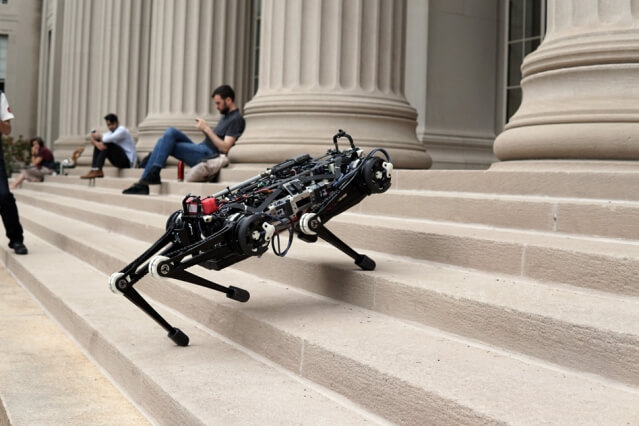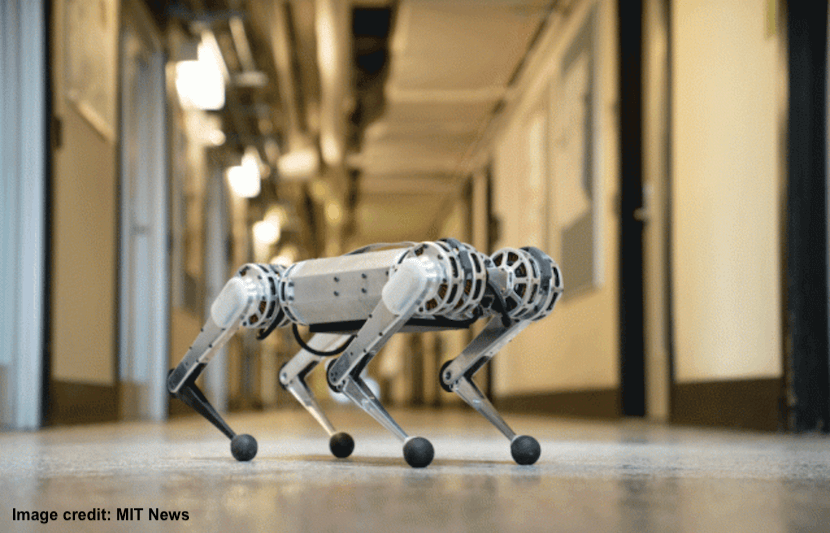The robotic cheetah is one of the most popular inventions MIT has developed in the 21st century. Its design, speed, size, strength and jumping ability has made it a fan favorite and given it real-world applications.
Now, a third generation robot, named the Cheetah 3, can travel swiftly across rough terrain, climb up stairs covered in debris, and easily recover its balance when pushed or yanked, without any source of vision.
The 90-pound, “blind” robot could eventually conduct power plant inspections, trek its way through sewer systems, save people in building fires, and improve mobility for the elderly population.
Instead of relying on cameras, the mechanical cat uses “blind locomotion” to feel its way through its surroundings.
“Blind locomotion technology makes the robot much more robust against unexpected situations such as stepping on obstacles or collisions with un-modeled objects,” said Sangbae Kim, an associate professor of mechanical engineering at MIT and designer of the robot.
“Vision can be noisy, slightly inaccurate, and sometimes not available, and if you rely too much on vision, your robot has to be very accurate in position and eventually will be slow,” he said in a statement. “So we want the robot to rely more on tactile information. That way, it can handle unexpected obstacles while moving fast.”
Compared to the Cheetah 2, this new robot has improved software and an expanded range of motion.
It can stretch forwards and backwards and twist from side to side, making it nimble and athletic like a big cat.
Advanced algorithms
Until this point, the researchers at the MIT Biomimetic Robotics Lab had not developed a machine with effective mobility on rough terrain.
Two new algorithms — a contact detection algorithm and a model-predictive control algorithm — give the Cheetah 3 the power to quickly recover its balance, trek through difficult terrain, travel up staircases, and move with the near efficiency of an animal.

The contact detection algorithm enables the robot to understand when it should stop a certain leg from swinging and place it on the ground.
This algorithm keeps the robot from losing its balance because it knows whether to carry through with a step or pull back its leg when encountering an obstacle.
In order for the robot to know when to transition legs, it constantly considers three probabilities — that of a leg touching the ground, the generated force from the leg hitting the ground, and if the leg will be in mid-swing.
The algorithm calculates the probabilities based on data from accelerometers, gyroscopes, and the angle and height of each leg with respect to the ground.
The robot’s body can react to unexpected obstacles. If it steps on something, its body and legs adjust so it can keep its balance.
“If humans close our eyes and make a step, we have a mental model for where the ground might be, and can prepare for it. But we also rely on the feel of touch of the ground,” Kim said in a statement. “We are sort of doing the same thing by combining multiple [sources of] information to determine the transition time.”
The model-predictive control algorithm determines how much force the robot should apply to each leg with each step so it can move its body in the most effective way.
More specifically, the algorithm works by looking a half-second into the future to calculate the proper position of robot’s body and legs.
“Say someone kicks the robot sideways,” Kim said in a statement. “When the foot is already on the ground, the algorithm decides, ‘How should I specify the forces on the foot? Because I have an undesirable velocity on the left, so I want to apply a force in the opposite direction to kill that velocity. If I apply 100 newtons in this opposite direction, what will happen a half second later?’ ”
The algorithm makes these calculations 20 times per second.
To test it, the researchers shoved, pulled and yanked the robot as it walked on a treadmill.
The researchers will present Cheetah 3 in October at the International Conference on Intelligent Robots, in Madrid.
Real-world applications
Unlike previous Cheetah robots, the Cheetah 3 is designed to keep people safe.
“This technology will allows us to develop a machine we can send in dangerous situation instead of sending a human,” said Kim.
The machine is expected to be ready to inspect power plants and chemical plants in two to three years.
In three to five years, it will be capable of navigating through sewers, said Kim.
In 15 years, it could potentially save someone from a burning building.
The Cheetah 3 is already capable of measuring temperatures and chemical compounds, opening heavy doors, and closing and opening valves.
“By utilizing the flexibility of the limbs, the Cheetah 3 can open the door with one leg,” Kim said in a statement. “It can stand on three legs and equip the fourth limb with a customized swappable hand to open the door or close a valve.”
In 20 years, Kim believes similar dynamic, legged robots could be ready to help the elderly at their homes.
“We still don’t have a technology that can help impaired or elderly people seamlessly move from the bed to the wheelchair to the car and back again,” he said in a statement.
“A lot of elderly people have problems getting out of bed and climbing stairs. Some elderly with knee joint problems, for example, are still pretty mobile on flat ground, but can’t climb down the stairs unassisted. That’s a very small fraction of the day when they need help. So we’re looking for something that’s lightweight and easy to use for short-time help.”
What’s next?
The researchers don’t intend on the robot being “blind” forever. In fact, they have already added some cameras to give it a visual of its surroundings so it is more aware of large obstacles.
But for now, the team is focused on improving the Cheetah’s blind motion.
“We want a very good controller without vision first,” Kim said in a statement. “And when we do add vision, even if it might give you the wrong information, the leg should be able to handle (obstacles). Because what if it steps on something that a camera can’t see? What will it do? That’s where blind locomotion can help. We don’t want to trust our vision too much.”



